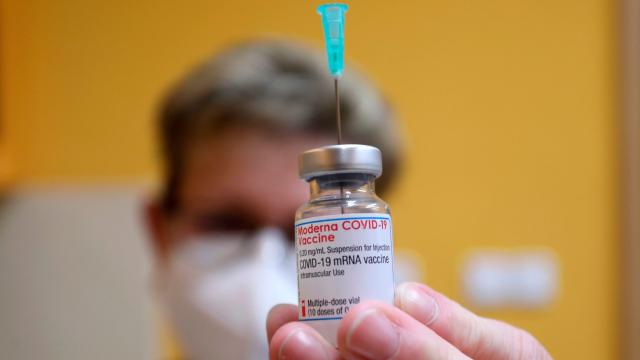A group of Stanford researchers has hacked Moderna’s messenger RNA (mRNA) vaccine for the novel coronavirus, Motherboard first reported on Monday, and published its entire genetic sequence on the open-source code repository Github.
The mRNA vaccines work by delivering genetic information that allows the body’s own cells to produce a viral protein — such as a harmless, engineered version of the spike protein that the coronavirus uses to break its way into the body’s cells. When the body subsequently produces that protein, the immune system rapidly mobilizes to fight it, conducting a sort of live-fire training exercise that prepares it to fight the actual coronavirus; the actual mRNA delivered by the vaccine quickly disintegrates, but the antibodies stick around as a garrison against future infection. Per the MIT News Office, this allows for much easier and faster production than prior generations of vaccines relying on manufacturing the proteins under laboratory conditions. The mRNA sequence more or less serves as a sort of source code for the vaccine.
The documents the Stanford team published on Github include two pages of explanation and two pages containing the entire mRNA sequence for Moderna’s vaccine. Researchers wrote in the report that although Moderna’s mRNA has ended up in a large swathe of the population, scientists and medical personnel don’t have access to the actual genetic sequences involved.
“With the rollout of vaccines for COVID-19, these synthetic mRNAs have become broadly distributed RNA species in numerous human populations,” the researchers wrote. “Despite their ubiquity, sequences are not always available for such RNAs… Sharing of sequence information for broadly used therapeutics has the benefit of allowing any researchers or clinicians using sequencing approaches to rapidly identify such sequences as therapeutic-derived rather than host or infectious in origin.”
The research team told Motherboard that they didn’t “reverse engineer” the vaccine, they simply “posted the putative sequence of two synthetic RNA molecules that have become sufficiently prevalent in the general environment of medicine and human biology in 2021.”
“As the vaccine has been rolling out, these sequences have begun to show up in many different investigational and diagnostic studies,” Stanford scientists Andrew Fire and Massa Shoura told Motherboard by email. “Knowing these sequences and having the ability to differentiate them from other RNAs in analysing future biomedical data sets is of great utility.”
“For this work, RNAs were obtained as discards from the small portions of vaccine doses that remained in vials after immunization; such portions would have been required to be otherwise discarded and were analysed under FDA authorization for research use,” they added. Fire and Shoura told Motherboard that they had received permission from the FDA to collect scraps of vaccines that wouldn’t have otherwise been used from empty vials and that they’d notified Moderna in advance of their plans to publish the sequence without receiving any objection in turn.
There is a “substantial economy of scale and educational value in having the sequences available ASAP and in not having to guess where they have come from,” the two researchers told Motherboard.
Moderna’s mRNA vaccine and the competing one made by Pfizer-BioNTech were the first ones ever approved by the Food and Drug Administration. Per Motherboard, PowerDNS founder Bert Hubert was able to use publicly available data to reveal Pfizer’s mRNA sequence late last year.
As Hubert wrote in a separate blog post, however, this does not mean that anyone is going to be homebrewing either vaccine soon in a “distributed manufacturing revolution.” Hubert detailed the ridiculously complicated supply chain that powers the pharmaceutical companies’ vaccine manufacturing, which involves numerous complex ingredients, DNA and mRNA production in specialised facilities, and combining mRNA and lipids into lipid nanoparticles (LNPs), the last of which perhaps only a number of experts in the “low hundreds” know how to do. The final steps, including formulation where the LNPs are mixed with other more generic ingredients and are filled into vials, also require specialised knowledge and equipment — with subsequent distribution to patients being its own daunting technical challenge.
“Technically, the last step of the supply chain of these mRNA COVID-19 vaccines is the production of the spike protein,” Hubert concluded. “That’s what happens in the cells of your body after you receive the vaccine. You are the globally distributed vaccine manufacturing revolution.”
Joe Biden’s administration is facing pressure from some legislators to suspend patent protections on COVID-19 vaccines, according to Time, in the hopes of ensuring that profit incentives won’t get in the way of attaining levels of mass vaccination that could snuff out the pandemic. (Former FDA commissioner Scott Gottlieb, a member of the Pfizer board of directors, has argued that bottlenecks in mass vaccination lay primarily in supplies and production, not intellectual property restrictions.) The White House is still considering whether to do that, according to CNBC.
[Wired]
